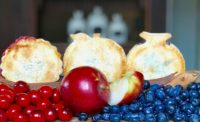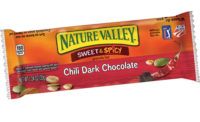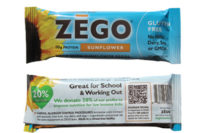In today’s snack food and bakery industries, portion control can take many forms. Nutritional and snack bars have shrunk to even-more-approachable sizes. Snack cakes have been selling well, and manufacturers of other indulgent treats have diversified into single-serve and miniature options. And calorie-controlled packaging of salty snacks continues to attract attention.
As noted in the June 2015 State of the Industry article on bars, for the 52 weeks ending April 19, 2015, the bar category saw sales of about $4.8 billion, according to IRI, Chicago. Nutritional and intrinsic health bars were responsible for $2.14 billion of that total, up 8.63 percent from the previous year.
Snack cakes fit directly within the concept of portion control, and the category was up 5.32 percent dollar share for the 52 weeks ending April 19, 2015, per IRI. The rebound of Hostess brand snacks played a significant role in improving category performance. Elsewhere in bakery snacks, miniature forms of doughnuts and muffins showed strength, with increased sales of Hostess Donettes and Entenmann’s Little Bites Muffins, up 40.46 percent and 16.35 percent, respectively, per IRI.
Salty snack producers have also capitalized on calorie control. The Snyder’s of Hanover 100-Calorie Pack is currently the No. 6 brand in the segment and grew by 17.05 percent in dollar sales to $18.33 million, for the 52 weeks ending May 17, 2015, per IRI.
For the complete State of the Industry reports on Snacks and Bakery, see the June and July issues of Snack Food & Wholesale Bakery at www.snackandbakery.com.
“Smaller snack sizes and better-for-you products are a large part of product innovation within the salty snacks category,” says Amanda Topper, food analyst, Mintel, Chicago.
This also holds true for baked goods. Mintel notes 28 percent of consumers would buy more desserts like cake or pie, if they were offered in individual portion sizes, and 20 percent would buy more prepared cake and pie products if miniature versions were available. Product formats that fit this concept include miniature pies or pie bites, mini Bundt cakes, and mini bar-cookie versions of cheesecake.
Downsized snacks
While makers of snack and nutritional bars have long understood the merits of portion control—one serving per bar—they’ve begun downsizing offerings. A clear trend in this category is also the scrubbing and simplifying of ingredient statements.
Frontier Snacks offers its Frontier Bites in small, bite-sized portions, in either resealable pouches or single-serving packaging containing five pieces (about 0.70 ounces). The products are made with nuts, sunflower seeds, brown rice syrup, honey, puffed millet, puffed rice, fruit and a flavorant (like cinnamon or lemon oil). The types of nuts and fruit featured vary depending on the product, with varieties including Macadamia Pineapple Coconut, Pecan Cherry Cinnamon and Almond Blueberry Lemon.
Another snack bar manufacturer that has taken the bite-sized route is The Gluten Free Bar, which released Gluten Free Bites in early 2015. Two “bites” account for one serving (about 0.77 ounces). They’re packaged in a resealable stand-up pouch in flavors like Chocolate Cherry Almond, Dark Chocolate Coconut, Coconut Cashew Crunch, PB & J, Dark Chocolate Peanut Butter, Blueberry Almond Crunch and Chocolate Hazelnut.
PROBAR is also taking a portion-controlled approach with PROBAR Bite. These smaller-portioned, 1.62-ounce nutritional bars have 190 calories each. They’re available in varieties like Chocolate Cherry Cashew, Coconut Almond, Mixed Berry, Peanut Butter Chocolate, Peanut Butter Crunch and Superfruit + Greens.
Snack mixes likewise provide a perfect opportunity for single-portion packaging. John B. Sanfilippo & Son Inc. offers mini, single-serving Orchard Valley Harvest products, including a Cranberry Almond Cashew Trail Mix with a roughly 1.83-ounce serving size.
Acceptable indulgences
As part of our recent State of the Industry reports on the snack and bakery industries, Mintel pulled several examples of on-trend, portion-controlled, traditionally indulgent products:
- 7-Eleven private label Fresh To Go Marble Pound Cake in a 3.3-ounce package
- General Mills Betty Crocker brand Caramel Brownie in a 1.7-ounce package
- Giant Eagle private label Itty Bitty Carrot Cupcakes in a 10-ounce package
- Rich Products Corp. Farm Rich brand Signature Sweets Apple Cinnamon Pie Bites and Chocolate Cream Brownie Bites, both in 12-ounce packages
- Atlanta Bread Co. Lemon Cake Bites in a 9.6-ounce package
While single-serve packaging helps make portion control more clear-cut for consumers, offering miniature versions of traditionally indulgent products opens the door to flexible serving sizes and snacking. For instance, Rich Products Corp. markets its Chocolate Cream Brownie Bites as “an after-school snack, a small after-dinner dessert fix or a bedtime snack.” Each “bite” has 52.5 calories.
In June, Lantmännen Unibake introduced its Schulstad Mini Signature Selection. The premium, artisanal pastries are available in five flavors: Cherry Chocolate Coronet, Toasted Coconut Swirl, Salted Caramel Braid, Strawberry Shortcake Crown and Lemon Cheesecake Lattice. Each pastry is a 1.60-ounce portion.
Tyson Food Service has also entered the mini dessert segment with its new Bistro Collection of individual Bundt cakes, designed to be split between two people, in flavors like Chocolate with Chocolate Ganache, Vanilla Bean with Raspberry, Chocolate Pecan with Salted Caramel, and Boston Crème with Chocolate, ranging from 3.25 to 3.75 ounces each.
Nutritional improvements
As Nutrition Facts and other label inspection grow more customary, boosting the nutritional components of downsized and miniature snacks and baked goods can help cultivate additional appeal.
Rajen Mehta, Ph.D., senior director, specialty ingredients, Grain Millers Inc., Eugene, OR, notes that four key opportunities exist to improve nutritionals: increasing fiber and protein, and decreasing fat and added sugar. “Choosing the right texturizing ingredients is critical when these changes in nutrients are made,” he says. He notes that his company offers functional flours and oat-flour sweeteners that can help manage texture and/or partially reduce added sugar by using lower dextrose-equivalent (DE) oat-flour ingredients. He also suggests whole grains, ancient grains, beans and pulses, nuts, and fruits help a product convey a positive nutritional stance.
Sodium content is also often a trigger for some consumers, and leavening can contribute a surprising amount. “There are several sodium-free leavening acids on the market, as well as low-sodium, reduced-sodium and sodium-free baking powders that utilize the sodium-free leavening acids, often along with potassium bicarbonate,” says Nita Livvix, R&D director, Clabber Girl Corp., Terre Haute, IN.
Jennifer Stephens, director of marketing, Fiberstar, River Falls, WI, notes that using natural citrus fiber in conjunction with protein ingredients can provide synergistic effects like improved moisture retention and emulsification. Other ingredients that can improve nutritional content include fruit or vegetable powders. “These dry concentrates have hit the market, providing the benefits of whole fruit and vegetables while maintaining a clean label,” she says, adding that using the citrus fiber with those ingredients can aid emulsification stabilization, thickening properties, moisture retention and better quality throughout shelf life.
Fruit ingredients can bring additional benefits to better-for-you benchtop development. “Substituting ingredients in recipes can decrease the sodium and added sugar content of foods, while still maintaining or improving the flavor,” says Jim Painter, Ph.D., R.D., adjunct professor, University of Texas, School of Public Health, and professor emeritus, Eastern Illinois University, Charleston, IL. For instance, in a product like fig-based cookies or bars, substituting raisin paste for sugar can cut total sugar and improve ingredient statement perception—“and is an excellent bonus for a person who is watching their blood sugar,” he says. “These raisin-containing products also have increased potassium, which is an important electrolyte for heart health and is listed as a nutrient of concern for inadequate intake by the USDA. Phenolic compounds and propionic acid found in raisins is an added benefit that exerts antimicrobial effects, which help to preserve food naturally.”
Painter also suggests replacing white flour with almond flour and a combination of date and raisin paste in an application like a cocoa coconut torte, a concept that bakers could potentially formulate as a snack cake. “Everyone knows that nuts and dried fruits are highly nutritious foods, but some people may not choose to eat these foods plain because of texture or flavor,” he says. “Incorporating almond flour and raisin paste in the form of a cake can help everyone become nut and dried fruit enthusiasts.”
In another option, pecan pie—a product well-suited to pie bites or hand pie formats—the filling is traditionally starch and sugar. Painter suggests replacing the filling with golden raisin purée to make the pie nutrient-dense with no added sugar.
Amanda Wagner, food technologist, Fiberstar, notes that the increased consumption of yogurt-based snack products over the past few years presents an opportunity. “Fortification of these types of products will benefit consumers in reaching their recommended daily allowances for fiber and ultimately reduce diseases associated with fiber deficiencies,” she explains. She adds that natural citrus fiber can help improve nutritional claims, as well as provide “improved sensory attributes, such as mouthfeel and overall texture, and provide long-term stability by reducing syneresis in yogurt snack applications.”
While Mehta notes that all snacks and baked goods can benefit from such formulation approaches, those that will have a “positive image” make the most sense, such as baked vs. fried items. This is particularly helpful when working with a formula for a traditionally indulgent item typically higher in calories, sugar and/or fat. He also suggests limiting the number of nutritional messages on packaging to a targeted two or three.
“The individual serving pack is an effective medium for communicating suggested portion size to consumers,” says Stephens. “In an ideal world, the packaging should indicate that the food product is a snack or an indulgence. However, there is a tendency for producers to highlight the nutritional composition, which can be a risky tactic. Positioning the snack in this manner tempts the consumer to disregard the portion-control suggestive and to fall in the trap of eating more to benefit from the nutritional claims. This defies the whole-weight management initiative.
“The winning situation is a portion-controlled food product that meets the consumer’s taste test and provides fulfillment,” she continues, “so they aren’t reaching for a second helping. A combination of product size and shape, texture, flavor and composition can achieve this.”
When presented as the complete—albeit smaller—nutritional package, portion-controlled foods can potentially have a big impact on select snack and bakery ?categories.







